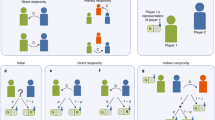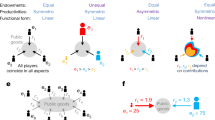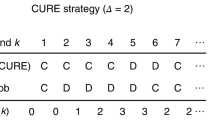Abstract
Reciprocity1, whether direct2 or indirect3, is thought to be the key to establishing cooperation among non-relatives. But Riolo et al.4 have presented a model in which cooperation is instead based on similarity: agents donate only when their partner's 'tag' lies within a 'tolerance' range around their own. Here we point out that their model requires individuals with identical tags to cooperate with each other, and show that cooperation tends to collapse when individuals bearing identical tags are given the option of not donating. We therefore question their mechanism for maintaining cooperation without reciprocity.
This is a preview of subscription content, access via your institution
Access options
Subscribe to this journal
Receive 51 print issues and online access
$199.00 per year
only $3.90 per issue
Buy this article
- Purchase on Springer Link
- Instant access to full article PDF
Prices may be subject to local taxes which are calculated during checkout

Similar content being viewed by others
References
Trivers, R. Q. Rev. Biol. 46, 35–57 (1971).
Axelrod, R. & Hamilton, W. D. Science 211, 1390–1396 (1981).
Nowak, M. A. & Sigmund, K. Nature 393, 573–577 (1998).
Riolo, R. L., Cohen, M. D. & Axelrod, R. Nature 414, 441–443 (2001).
Sigmund, K. & Nowak, M. A. Nature 414, 403–405 (2001).
Hamilton, W. D. J. Theor. Biol. 7, 1–52 (1964).
Dawkins, R. The Selfish Gene (Oxford Univ. Press, New York, 1976).
Roberts, G. Proc. R. Soc. Lond. B 265, 427–431 (1998).
Author information
Authors and Affiliations
Corresponding author
Rights and permissions
About this article
Cite this article
Roberts, G., Sherratt, T. Does similarity breed cooperation?. Nature 418, 499–500 (2002). https://doi.org/10.1038/418499b
Issue Date:
DOI: https://doi.org/10.1038/418499b
This article is cited by
-
Evolution of joint cooperation under phenotypic variations
Scientific Reports (2018)
-
Evolutionary Dynamics of Homophily and Heterophily
Scientific Reports (2016)
-
Testing Theories about Ethnic Markers
Human Nature (2015)
-
Different Selection Pressures Give Rise to Distinct Ethnic Phenomena
Human Nature (2015)
-
The Recognition Signal Hypothesis for the Adaptive Evolution of Religion
Human Nature (2012)
Comments
By submitting a comment you agree to abide by our Terms and Community Guidelines. If you find something abusive or that does not comply with our terms or guidelines please flag it as inappropriate.



